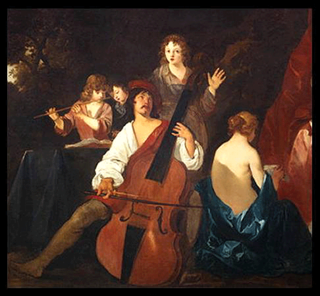
The viol, viola da gamba, or informally gamba, is any one of a family of bowed, fretted, and stringed instruments with hollow wooden bodies and pegboxes where the tension on the strings can be increased or decreased to adjust the pitch of each of the strings. Frets on the viol are usually made of gut, tied on the fingerboard around the instrument's neck, to enable the performer to stop the strings more cleanly. Frets improve consistency of intonation and lend the stopped notes a tone that better matches the open strings. Viols first appeared in Spain and Italy in the mid-to-late 15th century, and were most popular in the Renaissance and Baroque (1600–1750) periods. Early ancestors include the Arabic rebab and the medieval European vielle, but later, more direct possible ancestors include the Venetian viole and the 15th- and 16th-century Spanish vihuela, a six-course plucked instrument tuned like a lute that looked like but was quite distinct from the four-course guitar.
John Jenkins (1592–1678), was an English composer who was born in Maidstone, Kent and who died at Kimberley, Norfolk.

Tobias Hume was a Scottish composer, viol player and soldier.
John Coprario, also known as Giovanni Coprario or Coperario, was an English composer and viol player.

William Lawes was an English composer and musician.

A consort of instruments was a phrase used in England during the 16th and 17th centuries to indicate an instrumental ensemble. These could consist of the same or a variety of instruments. Consort music enjoyed considerable popularity at court and in the households of the wealthy in the Elizabethan era, and many pieces were written for consorts by the major composers of the period. In the Baroque era, consort music was absorbed into chamber music.
William Chappell was an English writer on music, a partner in the London musical firms of Chappell & Co. and, later, Cramer & Co.

The term violone can refer to several distinct large, bowed musical instruments which belong to either the viol or violin family. The violone is sometimes a fretted instrument, and may have six, five, four, or even only three strings. The violone is also not always a contrabass instrument. In modern parlance, one usually tries to clarify the 'type' of violone by adding a qualifier based on the tuning or on geography, or by using other terms that have a more precise connotation. The term violone may be used correctly to describe many different instruments, yet distinguishing among these types can be difficult, especially for those not familiar with the historical instruments of the viol and violin families and their respective variations in tuning.

Amanda Christina Elizabeth Aldridge, also known as Amanda Ira Aldridge, was a British opera singer and teacher who composed love songs, suites, sambas, and light orchestral pieces under the pseudonym of Montague Ring.

Jean-Baptiste Forqueray, the son of Antoine Forqueray, was a player of the viol and a composer.

Warner Chappell Music, Inc. is an American music publishing company and a subsidiary of the Warner Music Group. Warner Chappell Music's catalog consists of over 1.4 million compositions and 150,000 composers, with offices in over 40 countries.
The Rose Consort of Viols is an English ensemble of viol players who perform mainly early consort music, including works by Orlando Gibbons, John Dowland, and Henry Purcell.
Laurence Dreyfus, FBA is an American musicologist and player of the viola da gamba who was University Lecturer and Fellow of Magdalen College, Oxford.
"Here's a Health unto His Majesty" is an English patriotic song or glee. It is used as the regimental march of the Royal Army Medical Corps having been selected by Brigadier Hugh Llewellyn Glyn Hughes in 1948. Note the song is never "Here's A Health unto Her Majesty".
Alison Crum, is an English viol player.
Clare Wilkinson is an English mezzo-soprano specialising in Baroque and Renaissance music.
William Chappell was a British dancer, ballet designer and director. He is most noted for his designs for more than 40 ballets or revues, including many of the early works of Sir Frederick Ashton and Dame Ninette de Valois.
"My Robin is to the greenwood gone" or "Bonny Sweet Robin" is an English popular tune from the Renaissance.
The Musical Antiquarian Society was a British society established in 1840. It published, during seven years, 19 volumes of choral music from the 16th and 17th centuries.
Elway Bevin (c.1554-1638) was a Welsh-born organist and composer.







